7 long-term asset
- 格式:ppt
- 大小:525.00 KB
- 文档页数:51
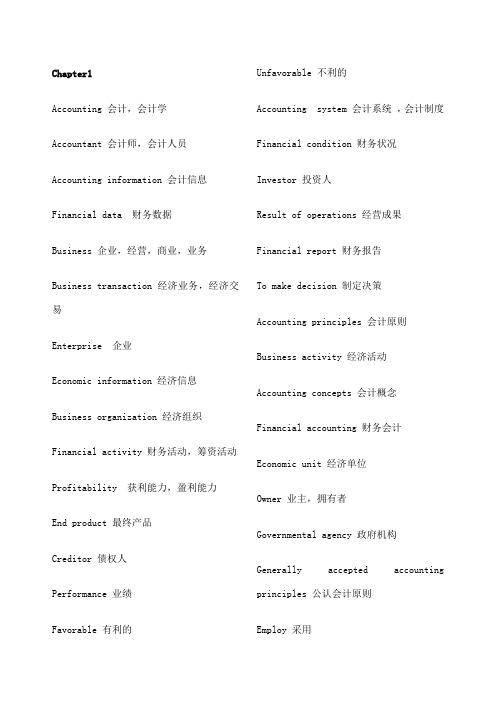
Chapter1Accounting 会计,会计学Accountant 会计师,会计人员Accounting information 会计信息Financial data 财务数据Business 企业,经营,商业,业务Business transaction 经济业务,经济交易Enterprise 企业Economic information 经济信息Business organization 经济组织Financial activity 财务活动,筹资活动Profitability 获利能力,盈利能力End product 最终产品Creditor 债权人Performance 业绩Favorable 有利的Unfavorable 不利的Accounting system 会计系统,会计制度Financial condition 财务状况Investor 投资人Result of operations 经营成果Financial report 财务报告To make decision 制定决策Accounting principles 会计原则Business activity 经济活动Accounting concepts 会计概念Financial accounting 财务会计Economic unit 经济单位Owner 业主,拥有者Governmental agency 政府机构Generally accepted accounting principles 公认会计原则Employ 采用Prepare 准备,编制Annual report 年度报告Stockholder 股东Audit 审计,审查,查帐Auditing 审计,审计学Accounting records 会计记录Public accountant 公共会计师Fairness 公正性,公允性Reliability 可靠性Periodic audit 定期审计Corporation 股份有限公司Internal auditor 内部审计人员Cost accounting 成本会计Cost data 成本数据Management accounting 管理会计Selling price 销售价格Management advisory service 管理咨询服务Management service 管理服务Tax accounting 税务会计Tax returns 纳税申报单,税单Budgetary accounting 预算会计International accounting 国际会计International trade 国际贸易Not-for-profit accounting 非盈利组织会计Not-for-profit organization 非盈利组织Social accounting 社会会计Measurement 计量Chapter2Accounting practice 会计实务Accounting theory 会计理论Decline 方针,指南Assumption 假设Business entity 经济主体Accounting entity 会计主体Economic activity 经济活动Bookkeeping 簿记Double-entry bookkeeping system 复试记账系统Entry分录,记录Single proprietorship独资Partnership合伙Accounting purpose会计目的Separate entity独立主体Asset资产Going-concern持续经营Historical cost历史成本Current market value 当前市场价值Accounting period会计期间Stable-monetary-unit货币计量单位Objective principle客观性原则Operating result经营成果Cost principle成本原则Actual cost实际成本Book value账面价值Equivalent当量,约当量Depreciation折旧Consistency principle一贯性原则Accounting method会计方法Financial statement 财务报告Comparability可比性Materiality principle重要性原则Conservatism principle谨慎性原则Revenue收入Expense费用Cost of goods商品成本Net income净收入Net loss净损失Accrual-basis 权责发生制Cash-basis 现金收付制Journal 日记账Realization principle 实现原则Matching principle 配比原则Recognize 确认Transfer转让,转帐,过户Income statement收益表,损益表Full-disclosure principle充分揭示原则Chapter3Accounting element会计要素Accounting equation会计等式Liability负债Owner s’ equity业主权益,所有者权益Current asset长期资产Long-term asset长期资产Operating cycle 经营周期Bank deposit 银行存款Short-term investment短期投资Long-term investment长期投资Accounts receivable应收账款Note receivable应收票据Prepayment 预付款项Inventory 存货Fixed asset 固定资产Plant and equipment 厂房和设备Intangible asset 无形资产Store fixtures店面装置Office equipment办公设备Delivery equipment运输设备Creditors’ equity债权人权益Obligation责任,义务Debt债务Current liability流动负债Long-term liability长期负债Short-time loans payable应付短期贷款Long-term loans payable长期应付贷款Notes payable应付票据Accounts payable应付账款Accrued expense应计费用Bonds payable应付债券Long-term accounting payable长期应付账款Interest 股份,利息Claim 要求权Net assets 净资产Capital资本Stockholder’s equity 股东权益Cost of goods sold 商品销售成本Administrative expenses 管理费用Selling expenses销售费用Financial expense 财务费用Occur 发生Dividend payable 应付股利Retained earnings留存收益Chapter4Classification分类,分级Day-to-day 随时Account title 账户名称Ledger 分类帐Debit side 借方Credit side 贷方Charge借记,收取费用Memorandum 摘要,备忘录Insert 插入,嵌入,写入Cash on hand 库存现金subgrouping子目,细目supplies 物料用品prepaid expenses 预付费用face value 面值check 支票bank draft 银行汇票money order 汇款单debtor 债务人bearer 持票人salaries payable 应付工资taxes payable 应付税费interest payable 应付利息long-term notes payable 长期应付票据mortgage payable 应付抵押借款bonds payable 应付公司债券drawing提款income summary收益汇总professions fees职业服务费commissions revenues 佣金收入interest income利息收入chart of accounts账户一览表executive salaries主管人员薪金office salaries办公人员薪金sales salaries销售人员薪金prepaid rent预付租金accumulated depreciation累计折旧depreciation expense折旧费用sales销售收入sales returns and allowance销售退回与折让purchases returns and allowance购买退回与折让Chapter5Accounting cycle会计循环Accounting procedures会计程序,会计方法Trial balance试算平衡表Post-closing trial balance结算后试算平衡表Journalize 做分录,记账Post to the ledger过入分类帐Assemble汇集Work sheet工作底表Adjusting entry调整分录close结账,结清,关闭ledger accounts分类账户general ledger总分类帐two-column account两栏式账户source document原始凭证check stub支票存根journal日记帐journal entry日记帐分录records(book) of original entry原始记录簿transcribe抄录post过账,誊帐manually手工的chronological按时间顺序的enter登记,计入general journal普通日记账special journal特殊日记帐sales journal销售日记帐purchases journal购买日记帐cash receipts journal现金收入日记帐cash disbursements journal现金支出日记帐division of labor分工Chapter6Adjusting procedures调整程序Accrual(basis) accounting权责发生制Align调整,使成一线,(转做)使一致Apportion(按比例)分配,摊配Accrue自然积累(如利息等),计提Outlay支出Expire期满,耗尽,失效Insurance expense保险费用Prepaid insurance 预付保险费Supplies expense物料用品费Supplies on hand在用物料Subscription预订Deferred credit递延贷项Accrued salaries payable应计应付工薪Accrued revenue应计收入Closing entry结账分录Closing procedure结账程序Temporary account临时性账户,名义账户,虚账户Permanent account 永久性账户,实账户Withdrawals提款Statement of cash flow现金流量表Financial position财务状况Portray描绘Dispose处理Inflows流入Outflows流出Chapter7Working paper工作底稿Adjusted trial balance调整后试算平衡表Cross-reference交叉参考Occasion需要,机会,工作场合Salaries accrued应计薪金Combine结合,联合Extend(会计)将数字转入。
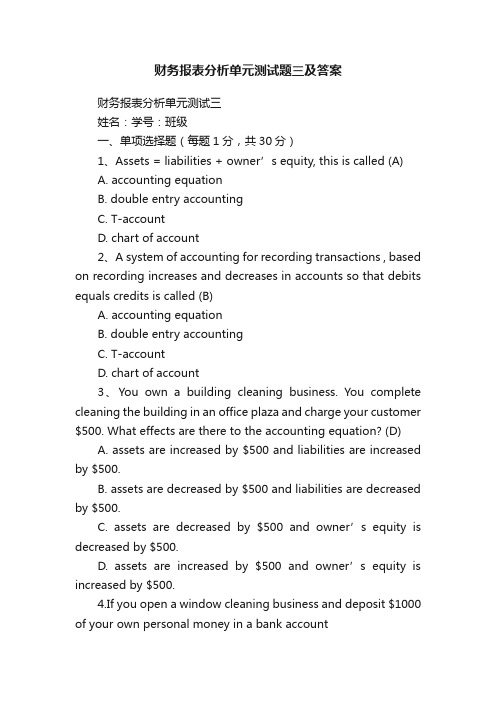
财务报表分析单元测试题三及答案财务报表分析单元测试三姓名:学号:班级一、单项选择题(每题1分,共30分)1、Assets = liabilities + owner’s equity, this is called (A)A. accounting equationB. double entry accountingC. T-accountD. chart of account2、A system of accounting for recording transactions , based on recording increases and decreases in accounts so that debits equals credits is called (B)A. accounting equationB. double entry accountingC. T-accountD. chart of account3、You own a building cleaning business. You complete cleaning the building in an office plaza and charge your customer $500. What effects are there to the accounting equation? (D)A. assets are increased by $500 and liabilities are increased by $500.B. assets are decreased by $500 and liabilities are decreased by $500.C. assets are decreased by $500 and owner’s equity is decreased by $500.D. assets are increased by $500 and owner’s equity is increased by $500.4.If you open a window cleaning business and deposit $1000 of your own personal money in a bank accountfor the business, what effects are there to the accounting equation? (B)A. assets are decreased and liabilities are decreasedB. assets are increased and owner’s equity is increased.C. assets are increased and owner’s equity is decreased.D. liabilities are decreased and owner’s equity is increased.5、You own a lawn service business. If you charge a customer $30 for mowing their lawn, what is the $30 to your business? (A)A. revenueB. an expenseC. a liabilityD. an obligation6、You own a lawn service business. You pay $500 for gasoline and store it in a holding tank. What is the gasoline? (C)A. an expenseB. a liabilityC. an assetD. owner’s equity7、You have ownership of a lawn service business. You store gasoline in a holding tank and draw it out as you need it. You mow lawns all day and use $20 worth of gasoline. What is the $20 worth of gasoline? (A)A. an expenseB. a liabilityC. an assetD. owner’s equity8、The amount of money received and deposited in the bank should be recorded in which of the following accounts? (B)A. money receivedB. cashC.. liquid resourcesD. accounts receivable9、When a business purchased supplies to be used over the next few months, it should record the cost ofthe supplies in what account? (C)A. supplies expenseB. supplies usableC. supplies inventoryD. none of the above10、A credit customer paid their bill. This should be recorded in which of the following accounts? (C)A. accounts payableB. accounts dueC. accounts receivableD. capital11、When an account is entered on the left side of an account ,it is a (A)A. debitB. creditC. debitedD. credited12、When an account is entered on the right side, it is a (B)A. debitB. creditC. debitedD. credited13、Debits and credits are sometimes abbreviated as (C)A. D and CB. De and CrC. Dr and CrD. De and Ce14、The difference between the debits and the credits is called (B)A. footingsB. the ending balanceC. assetD. liability15、Which of the account has a debit balance?(A)A. account receivableB. account payableC. notes payableD. revenue16、Which of the account has a credit balance?(B)A. account receivableB. account payableC. cashD. expense17、Increases in assets are (D)to asset accounts.A. creditB. creditedC. debitD. debited18、Decreases in assets are (B)to asset accounts.A. creditB. creditedC. debitD. debited19、Increases in liability are (B)to liability accounts.A. creditB. creditedC. debitD. debited20、Decreases in liability are (D)to liability accounts.A. creditB. creditedC. debitD. debited21、Increases in capital are (B)to capital accounts.A. creditB. creditedC. debitD. debited22、Decreases in capital are (D)to capital accounts.A. creditB. creditedC. debitD. debited23、Why the increases in revenue accounts are credited?(C)A. because revenue can increase assetB. because revenue can decrease assetC. because revenue can increase capitalD. because revenue can decrease capital24、Why the increases in expense accounts are debited?(C)A. because expense can decrease assetB. because expense can increase assetC. because expense can decrease capitalD. because expense can increase capital25、Mr.Himes invested $4000 in cash to open his practice. The two accounts affected are(C)A. cash and revenueB. cash and accounts receivableC. cash and capitalD. cash and expense26、Bought office supplies on account. The two accounts affected are (D)A. supplies and cashB. supplies and accounts receivableC. supplies expense and accounts payableD. supplies and accounts payable27、Bought office furniture ,paid one third, the other is on account. The accounts affected are (A)A. office furniture, cash, accounts payableB. office furniture, accounts receivable, cashC. cash, capital, office furnitureD. capital, office furniture, accounts payable28、Paid office rent for March, $500. The two accounts affected are (D)A. cash and accounts payableB. accounts receivable and rent expenseC. cash and accounts receivableD. rent expense and cash29、Paid $1200 to Stanley Furniture Company on account. The accounts affected are (B)A. cash and accounts receivableB. cash and accounts payableC. accounts payable and expenseD. cash and capital30、下面哪一个是应收账款周转天数。
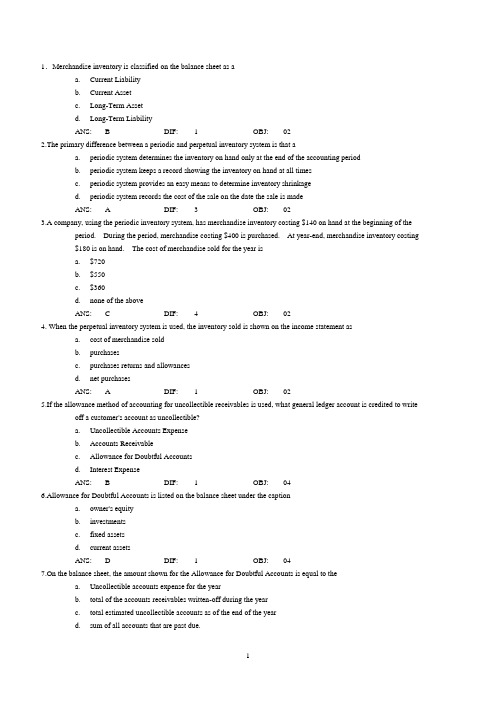
1.Merchandise inventory is classified on the balance sheet as aa. Current Liabilityb. Current Assetc. Long-Term Assetd. Long-Term LiabilityANS: B DIF: 1 OBJ: 022.The primary difference between a periodic and perpetual inventory system is that aa. periodic system determines the inventory on hand only at the end of the accounting periodb. periodic system keeps a record showing the inventory on hand at all timesc. periodic system provides an easy means to determine inventory shrinkaged. periodic system records the cost of the sale on the date the sale is madeANS: A DIF: 3 OBJ: 023.A company, using the periodic inventory system, has merchandise inventory costing $140 on hand at the beginning of theperiod. During the period, merchandise costing $400 is purchased. At year-end, merchandise inventory costing $180 is on hand. The cost of merchandise sold for the year isa. $720b. $550c. $360d. none of the aboveANS: C DIF: 4 OBJ: 024. When the perpetual inventory system is used, the inventory sold is shown on the income statement asa. cost of merchandise soldb. purchasesc. purchases returns and allowancesd. net purchasesANS: A DIF: 1 OBJ: 025.If the allowance method of accounting for uncollectible receivables is used, what general ledger account is credited to writeoff a customer's account as uncollectible?a. Uncollectible Accounts Expenseb. Accounts Receivablec. Allowance for Doubtful Accountsd. Interest ExpenseANS: B DIF: 1 OBJ: 046.Allowance for Doubtful Accounts is listed on the balance sheet under the captiona. owner's equityb. investmentsc. fixed assetsd. current assetsANS: D DIF: 1 OBJ: 047.On the balance sheet, the amount shown for the Allowance for Doubtful Accounts is equal to thea. Uncollectible accounts expense for the yearb. total of the accounts receivables written-off during the yearc. total estimated uncollectible accounts as of the end of the yeard. sum of all accounts that are past due.8.Allowance for Doubtful Accounts has a credit balance of $1,100 at the end of the year (before adjustment), and an analysisof customers' accounts indicates doubtful accounts of $12,900. Which of the following entries records the proper provision for doubtful accounts?a. debit Uncollectible Accounts Expense, $14,000; credit Allowance for Doubtful Accounts, $14,000b. debit Allowance for Doubtful Accounts, $14,000; credit Uncollectible Accounts Expense, $14,000c. debit Allowance for Doubtful Accounts, $11,800; credit Uncollectible Accounts Expense, $11,800d. debit Uncollectible Accounts Expense, $11,800; credit Allowance for Doubtful Accounts, $11,800ANS: D DIF: 3 OBJ: 049.Allowance for Doubtful Accounts has a credit balance of $1,500 at the end of the year (before adjustment), and an analysisof customers' accounts indicates doubtful accounts of $17,900. Which of the following entries records the proper provision for doubtful accounts?a. debit Allowance for Doubtful Accounts, $16,400; credit Uncollectible Accounts Expense, $16,400b. debit Allowance for Doubtful Accounts, $19,400; credit Uncollectible Accounts Expense, $19,400c. debit Uncollectible Accounts Expense, $19,400; credit Allowance for Doubtful Accounts, $19,400d. debit Uncollectible Accounts Expense, $16,400; credit Allowance for Doubtful Accounts, $16,400ANS: D DIF: 3 OBJ: 0410.In credit terms of 1/10, n/30, the "1" represents thea. number of days in the discount periodb. full amount of the invoicec. number of days when the entire amount is dued. percent of the cash discountANS: D DIF: 1 OBJ: 0311.Merchandise with a sales price of $500 is sold on account with term 2/10, n/30. The journal entry to record the salewould include aa. debit to Cash for $500b. Debit to Sales Discounts for $10c. Credit to Sales for $500d. Debit to Accounts Receivable for $$490ANS: C DIF: 2 OBJ: 0312.Merchandise subject to terms 1/10, n/30, FOB shipping point, is sold on account to a customer for $15,000. The sellerpaid transportation costs of $1,000 and issued a credit memorandum for $5,000 prior to payment. What is theamount of the cash discount allowable?a. $160b. $150c. $140d. $100ANS: D DIF: 3 OBJ: 0313. If the direct write-off method of accounting for uncollectible receivables is used, what general ledger account isdebited to write off a customer's account as uncollectible?a. Uncollectible Accounts Payableb. Accounts Receivablec. Allowance for Doubtful Accountsd. Uncollectible Accounts Expense14. If the direct write-off method of accounting for uncollectible receivables is used, what general ledger account iscredited to write off a customer's account as uncollectible?a. Uncollectible Accounts Expenseb. Accounts Receivablec. Allowance for Doubtful Accountsd. Interest ExpenseANS: B DIF: 1 OBJ: 0515. One of the weaknesses of the direct write-off method is that ita. understates accounts receivable on the balance sheetb. violates the matching principlec. is too difficult to use for many companiesd. is based on estimatesANS: B DIF: 2 OBJ: 0516.The amount of the promissory note plus the interest earned on the due date is called thea. realizable valueb. maturity valuec. face valued. net realizable valueANS: B DIF: 1 OBJ: 0617.A 60-day, 10% note for $8,000, dated April 15, is received from a customer on account. The face value of the note isa. $8,600b. $7,200c. $8,800d. $8,000ANS: D DIF: 1 OBJ: 0618.A 90-day, 12% note for $10,000, dated May 1, is received from a customer on account. The maturity value of the note isa. $10,000b. $10,300c. $450d. $9,550ANS: B DIF: 3 OBJ: 0619.On November 1, Blazer Company receives a 6% interest bearing note from Ram Company to settle a $20,000 accountreceivable. The note is due in six months. At December 31, Blazer should record interest revenue ofa. $0b. $100c. $200d. $600ANS: C DIF: 3 OBJ: 0720.A $6,000, 30-day, 12% note recorded on November 21 is not paid by the maker at maturity. The journal entry torecognize this event isa. debit Cash, $6,060; credit Notes Receivable, $6,060b. debit Accounts Receivable, $6,060; credit Notes Receivable, $6,000; Credit Interest Receivable, $60c. debit Notes Receivable, $6,060; credit Accounts Receivable, $6,060d. debit Accounts Receivable, $6,060; credit Notes Receivable, $6,000; Credit Interest Revenue, $60ANS: D DIF: 3 OBJ: 0721.Receivables are usually listed on the balance sheet after Cash in what order?a. Accounts Receivable, Notes Receivable, Interest Receivableb. Interest Receivable, Notes Receivable, Accounts Receivablec. Notes Receivable, Interest Receivable, Accounts Receivabled. Notes Receivable, Accounts Receivable, Interest ReceivableANS: D DIF: 2 OBJ: 0822.The inventory method that considers the inventory to be composed of the units of merchandise acquired earliest is calleda. first-in, first-outb. last-in, first-outc. average costd. retail methodANS: B DIF: 2 OBJ: 0323.Under which method of cost flows is the inventory assumed to be composed of the most recent costs?a. average costb. last-in, first-outc. first-in, first-outd. weighted averageANS: C DIF: 2 OBJ: 0324.The inventory data for an item for November areNov. 1 Inventory.........20 units at $204 Sold................. 10 units10 Purchased.........30 units at $2117 Sold................. 20 units30 Purchased.........10 units at $22Using the perpetual system, costing by the first-in, first-out method, the last-in, first-out method ,what is the cost of the merchandise inventory of 30 units on November 30?a. $640,630b. $610, 620c. $620,610d. $630, 640ANS: A DIF: 3 OBJ: 0425.During a period of consistently rising prices, the method of inventory that will result in reporting the greatest cost ofmerchandise sold isa. FIFOb. LIFOc. average costd. weighted averageANS: B DIF: 5 OBJ: 0626.Accumulated Depreciationa. is used to show the amount of cost expiration of intangiblesb. is the same as Depreciation Expensec. is a contra asset accountd. is used to show the amount of cost expiration of natural resourcesANS: C DIF: 1 OBJ: 0127.A building with an appraisal value of $137,000 is made available at an offer price of $142,000. The purchaser acquiresthe property for $30,000 in cash, a 90-day note payable for $40,000, and a mortgage amounting to $60,000. The cost basis recorded in the buyer's accounting records to recognize this purchase isa. $137,000b. $142,000c. $130,000d. $100,000ANS: C DIF: 3 OBJ: 0128 A new machine with a purchase price of $94,000, with transportation costs of $8,000, installation costs of $6,000, andspecial acquisition fees of $2,000, would have a cost basis ofa. $ 96,000b. $108,000c. $102,000d. $110,000ANS: D DIF: 3 OBJ: 0129.A fixed asset's estimated value at the time it is to be retired from service is calleda. book valueb. residual valuec. market valued. carrying valueANS: B DIF: 1 OBJ: 0230.All of the following below are needed for the calculation of depreciation excepta. costb. residual valuec. estimated lifed. book valueANS: D DIF: 1 OBJ: 0231.A machine with a cost of $65,000 has an estimated residual value of $5,000 and an estimated life of 5 years or 15,000hours. It is to be depreciated by the units-of-production method. What is the amount of depreciation for thesecond full year, during which the machine was used 5,000 hours?a. $8,000b. $20,000c. $12,000d. $21,667ANS: B DIF: 3 OBJ: 0232.Equipment with a cost of $160,000 has an estimated residual value of $10,000 and an estimated life of 5 years or 12,000hours. It is to be depreciated by the straight-line method. What is the amount of depreciation for the first full year, during which the equipment was used 3,300 hours?a. $30,000b. $32,500c. $34,000d. $40,000ANS: A DIF: 3 OBJ: 0233.A machine with a cost of $65,000 has an estimated residual value of $5,000 and an estimated life of 4 years or 18,000hours. What is the amount of depreciation for the second full year, using the declining-balance method at double the straight-line rate?a. $15,000b. $30,000c. $16,250d. $32,500ANS: C DIF: 3 OBJ: 0234.The depreciation method that does not use residual value in calculating the first year's depreciation expense isa. straight-lineb. units-of-productionc. declining-balanced. none of the aboveANS: C DIF: 1 OBJ: 0235. When a company discards machinery that is fully depreciated, this transaction would be recorded with thefollowing entrya. debit Accumulated Depreciation; credit Machineryb. debit Machinery; credit Accumulated Depreciationc. debit Cash; credit Accumulated Depreciationd. debit Depreciation Expense; credit Accumulated DepreciationANS: A DIF: 3 OBJ: 0436. When a company sells machinery at a price equal to its book value, this transaction would be recorded with anentry that would include the following:a. debit Cash and Accumulated Depreciation; credit Machineryb. debit Machinery; credit Cash and Accumulated Depreciationc. debit Cash and Machinery; credit Accumulated Depreciationd. debit Cash and Depreciation Expense; credit Accumulated DepreciationANS: A DIF: 3 OBJ: 0437.On June 8, Acme Co. issued an $80,000, 6%, 120-day note payable to Still Co. What is the due date of the note?a. October 8b. October 7c. October 6d. October 5ANS: C DIF: 1 OBJ: 0238.On June 8, Acme Co. issued an $80,000, 6%, 120-day note payable to Still Co. What is the maturity value of the note?a. $80,100b. $84,800c. $81,600d. $81,200ANS: C DIF: 3 OBJ: 0239.On June 8, Acme Co. issued an $80,000, 6%, 120-day note payable to Still Co. Assume that the fiscal year of Acme Co.ends June 30. What is the amount of interest expense recognized by Acme in the current fiscal year?a. $293.33b. $400.00c. $391.11d. $1,600.00ANS: A DIF: 3 OBJ: 0240.On June 8, Acme Co. issued an $80,000, 6%, 120-day note payable to Still Co. Assume that the fiscal year of Still Co.ends June 30. What is the amount of interest revenue recognized by Still in the following year?a. $1,200.00b. $1,208.89c. $1,306.67d. $1,600.00ANS: C DIF: 3 OBJ: 0241.On June 8, Acme Co. issued an $80,000, 6%, 120-day note payable to Still Co. Assume that the fiscal year of Acme Co.ends June 30. Which of the following relationships is true?a. Acme is the creditor and credits Accounts Receivableb. Still is the creditor and debits Accounts Receivablec. Still is the borrower and credits Accounts Payabled. Acme is the borrower and debits Accounts PayableANS: D DIF: 2 OBJ: 0242. A business borrowed $40,000 on March 1 of the current year by signing a 30 day, 6% interest bearing note. When thenote is paid on March 31, the entry to record the payment should include aa. debit to Interest Payable $200b. debit to Interest Expense $200c. credit to Cash for $40,000d. credit to Cash for $42400ANS: B DIF: 2 OBJ: 0243. The journal entry a company uses to record the issuance of a note for the purpose of converting an existing accountpayable would bea. debit Cash; credit Accounts Payableb. debit Accounts, Payable; credit Cashc. debit Cash; credit Notes Payabled. debit Accounts Payable; credit Notes PayableANS: D DIF: 2 OBJ: 0244. The journal entry a company uses to record the issuance of a note for the purpose of borrowing funds for the business isa. debit Accounts Payable; credit Notes Payableb. debit Cash; credit Notes Payablec. debit Notes Payable; credit Cashd. debit Cash and Interest Expense; credit Notes PayableANS: B DIF: 2 OBJ: 0245.The journal entry a company uses to record the issuance of a discounted note for the purpose of borrowing funds for thebusiness isa. debit Cash and Interest Expense; credit Notes Payableb. debit Cash and Interest Payable; credit Notes Payablec. debit Accounts Payable; credit Notes Payabled. debit Notes Payable; credit CashANS: A DIF: 2 OBJ: 02。
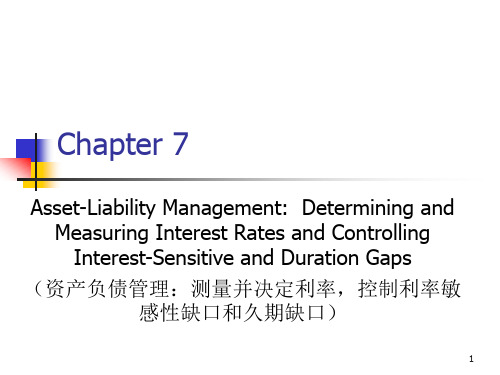

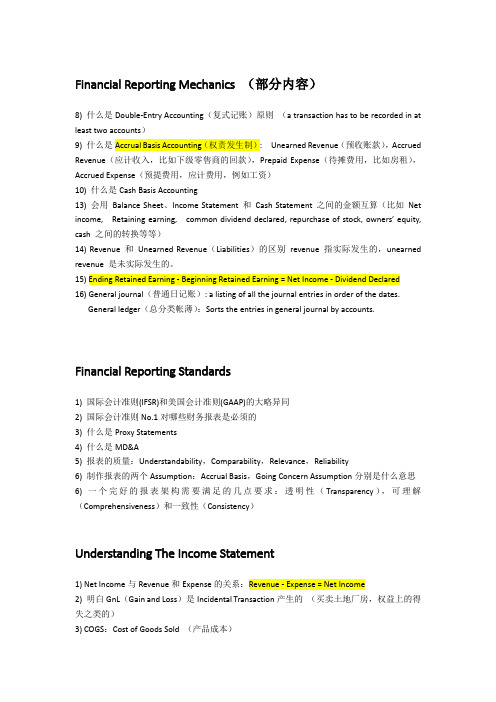
1.Accounting会计(学): is an information and measurement system that id entifies records andcommunicates relevant reliabl e and comparabl e information about an organization’s businessactivities.2.Managerial accounting管理会计: is the area of accounting that serves the d ecision-marking needs ofinternal users3.Events项目: refer to happenings that affect an entity’s accounting equation and can be reliablymeasured.4.External user外部使用者: of accounting information are not directly involved in running theorganization.5.Internal user内部使用者: of accounting information are those directly efficiency and effectivenessof an organization.6.Ethics: are beliefs that distinguish right from wrong. They are accepted standards of good and badbehavior.7.Cost principl e(历史)成本原则: means that accounting information is based on actual cost.8.Revenue recognition principl e(营业)收入确定原则: provid es guidance on when a company mustrecognize revenue.9.Matching principl e配合原则,收支对应原则: prescribes that a company must records its expensesincurred to generate the revenue reported.10.Going-concerning assumption持续经营假设: means that accounting information refl ects apresumption that the business will continue operating instead of being cl osed or sol d.11.Audit审计,审核: through review of an organization’s accounting records and accounting reportsand return make by the analysis. income净收益,收益净额: amount a business earns after paying all expenses and costsassociated with its sales and revenues.13.Income statement损益表: d escribes a company’s revenues and expenses al on g with the resulting netincome or l oss over a period time due to earnings activities.14.Statement of owner’s equity所有者: explains changes in equity from net income (or l oss) and fromany owner investments and withdrawals over a period of time.15.Balance sheet资产负债表,平衡表: d escribes a company’s financial position (types and amounts ofassets liabilities and equity) at a point in time.16.Statement of cash fl ows现金流量表: id entifies cash infl ows (receipts) and cash outfl ows (payments)over a period of time.17.Owner’s withdr awals account所有者提款账户: the account used to record the transfers of assetsfrom a business to its owner.18.Liabilities负债: is what a company owes its no owners (creditors) in future payments, products, orservices.19.Accounting equation会计恒等式: Assets=Liabilities + Equity.20.Accrued expense应计费用,预提费用: refer to costs that are incurred in a period but are bothunpaid and unrecord ed.21.Operating cycl e:经营周期is the time span from when cash is used to acquire goods and servicesuntil cash is received from the sale of goods and services.22.Sharehol d ers (investors):股东,投资者are the owners of a corporation.23.Current radio:目前的广播电a ratio used to help evaluate a company’s ability to pay its d ebts in thenear future.24.Merchandise inventory:库存商品,商品盘存refers to products that a company owns and intends tosell.25.Cash discount:现金折扣,现金贴现reduction in a receivabl e or payabl e if it is paid within thediscount period. sellers can grant a cash discount to discourage buyers to pay earlier26.Gross profit:总利润also call ed Gross margin, which equals net sales cost of goods sold.27.Credit period:付款/信贷期限the amount of time all owed before full payment is due.28.Acid-test ratio酸性比率测试: a ratio used to assets a company’s ability to pay its current liabilities;d efined by current liabilities.29.Selling expense:销售费用includ e the expenses of promoting sales by displaying and advertisingmerchandise, making sales, and d elivering goods to customers.(P124)30.General and administrative expense(一般)管理费用: support a company’s overall operatio ns andinclud e expenses related to accounting, human resource management, and financial management. 31.Time period assumption: 会计分期假设presumes that the life of a company can be divid ed intotime periods, such as months and years, and that useful reports can be prepared for those periods.32.Account receivabl e:应收账款are held by a sell er and d ecreased by customers to sell ers.33.Prepaid account (also call ed prepaid expenses): 预付费用/待摊费用are assets that representprepayments of future expenses (not current expenses).34.Purchase discount:购物折扣purchaser’s d escripti on of a cash discount received from a supplier ofgoods.35.Sales discount:销售折扣sell er’s d escription of a cash discount granted to buyers in return for earlypayment.36.Trad e discount:商业折扣reduction below list or catalog price hat is negotiated in setting the price ofgoods.37.FOB shipping point (FOB factory):寄发地交货means the buyer accepts ownership when the goodsd epart the s eller’s place of business.38.FOB d estination: 目的地交货,离岸交货means ownership of goods transfers to the buyer when thegoods arrive at the b uyer’s pl ace of business.39.Credit terms: 信贷条件,赊销付款条件for a purchase includ e the amounts and timing of paymentsfrom a buy to a seller.40.Current assets:流动资产are cash and other resources that are expected to be sol d, coll ect, or usedwithin one year or the company’s op erating cycle, whichever is l onger.41.Plant assets: 固定资产refers to l ong-term tangibl e assets used to produce and sell products andservices.42.Long-term investment:长期投资notes receivabl e and investments in stocks and bonds are long-termassets when they are expected to be hel d for more than the l onger of one year or the operating cycl e.43.Intangibl e assets:无形资产are long-term resources that benefit business operations, usually lackphysical form, and have uncertain benefits. (P98)44.Current liabilities: 流动负债are obligations due to be paid or settled within one year or theoperating cycl e, whichever is l onger.(P98)45.Long-term liabilities长期负债: are obligations not due within one year or the operating cycl e,whichever is l onger.46.Accounting cycl e:会计周期refers to the steps in preparing financial statements.(P95)47.Temporary (or nominal) accounts:临时账户,名义账户accumulate data related to one accountingperiod.48.Permanent (or real) accounts:永久账户,实际账户report on activities related to one or more futureaccounting periods.49.account reveivabl e(应收账款)are liquid assets,usually being converted into cash within a period of30 to 60 days. Therefore, accounts receivabl e from customers are classified as current assets,appearing in the balance sheet immediately after cash and marketabl e securities.50.d oubl e entry accounting(复式记账法)is a standard accounting method that involves each transactionbeing record ed in at l east two accounts, resulting in a d ebit to one or more accounts and a credit to one or more accounts.51.materiality(重要性原则)refers to the magnitud e of an omission or misstatement of accountinginformation that, consid ering the circumstances ,make it likely that the judgment of a reasonabl e person relying on the information would have been influenced by the omission or misstatement. 52.perpetual inventory system(定期盘存制)Und er the perpetual inventory system,the inventoryrecords are kept up-to-date.Virtually all large business organizations use perpetual inventorysystems.53.unearned revenue(预收账款/预收收入)A liability for unearned revenue arises when a customerpays in advance.54.financial statement(财务报表)Four related accounting reports that summarize the current financialposition of an entity and the results of its operations for the preceding year(or other thim period) 55.historical cost(历史成本)The historical cost of an asset is the exchange price in the transaction inwhich the asset was acquired56.d epreciation(折旧)The systematic allocation of the cost of an asset to expense over the years of itsestimated useful57.accrued liabilities(应计负债)The liabilities to pay an expense which has accrued during theperiod.Accrued liabilities are also call ed accrued expenses.58.income(收入)is d efined as increases in economic benefits during the reporting period,in the form ofinfl ows or enhancements of assets,or d ecreases of liabilities tha result in increases in equity,other than those relating to contributions from equity participants.Income encompasses both revenue and gains.59.asset(资产)is a resource controll ed by the enterprise as a result of past events and from whichfuture economic benefits are expected to fl ow to the enterprise.60.account payabl e(应付账款)often are subdivid ed into categories of trad e accounts payabl e and otheraccounts payabl e.Trad e accounts payabl e are short—term obligations to suppliers for purchases or merchandise.Other accounts payabl e includ e liabilities for any goods and services other thanmerchandise.61.FIFO(先进先出法)A method of computing the cost of inventory and the cost of goods sold based onthe assumption that the first merchandise acquired is the first merchandise sol d,and that the ending inventory consists of the most recently acquired goods.62.Goodwill(商誉)The present value of expected future earnings of a business in excess of the earningsnormally realized in the industry.63.cost principl e(历史成本原则)The cost principl e states that assets shoul d by record ed at theircost.Cost is the value exchanged at the time something is acquired.64.权责发生制accrual basis of accounting: Means that revenues, expenses and other changes in assets,liabilities, and owners’ equity are accounted for in the period in which the economic event takes place, not necessarily when the cash infl ows and outfl ows take place利润表income statement :An income statement is a financial statement showing the results of operations for a business by matching revenue and related expenses for a particular accountingperiod .It shows the net income or net loss.永续盘存制perpetual inventory system: Is a system of accounting for merchandise that provid es a continuous record showing the quantity and cost of all goods on hand.总账账户control accounts: Grouped according to the el ements of financial statement, the general l edger hol ds the individual control accounts.费用Expense: Generally speaking, expenses are costs that are charged against ,revenue and that are related to the entity’s basic business.二简答题1.State the steps of establishing internal control over cash(简述建立现金内部控制的程序) (1)Separate the function of handling cash from the maintenance of accounting records(将现金收付与记账职务分离)(2)Prepare an immediate control listing of cash receipts at the time and place that themoney is received(在收到现金的当时当地编制一份现金收入控制清单)(3)Require that all cash receipts be d eposited daily in the bank(每日都要将现金收入存入银行)(4)Make all payments by check(所有的付款都以支票形式通过银行支付)(5)Separate the function of approving expenditures from the function of signing checks(将核准支出职务与签发支票职务分离)2.What are the quality chatacteristics of accounting information(会计信息质量特征):Rel evance(相关性),reliability(可靠性),und erstandability(可理解性),comparability(可比性)3.Describe the steps(procedures) of accounting cycl e(描述会计循环的步骤)(1)id entify transactions or events to be record ed(确认需要记录的交易或事项)(2)journalize transactions and events(将交易或事项登记到日记账)(3)posting from journal to l edger(从日记账过入)(4)prepare unadjusted trial balance(编制调整前余额试算表)(5)journalize and post adjusting journal entries(将调整分录计入日记账并过入分类账)(6)prepare adjusted trial balance(编制调整后余额试算表)(7)prepare financial statements(编制财务报表)(8)journalize and post cl osing entries(将结账分录计入日记账并过账)(9)prepare post-cl osing trial balance(编制结账后余额试算表)4.Briefly state the four assumptions and explain(简述四个会计假设)Separate entity(会计主体假设),going concern(持续经营假设).,time-period(会计分期假设),monetary unit(货币计量假设)5.Briefly state the classification investment in securities(简述有价证券的列报)Trading securities(交易性证券),held-to-maturity securities(持有至到期投资),availabl e-for-sale securities(可供出售的金融资产),l ong-term investment in equity securities(长期股权投资)6.What are the accounting el ements(会计要素)Assets(资产),liabilities(负债),owners’ equity(所有者权益),revenues(收入),expenses(费用),income (利润)d oubl e-entrybookkeeping 复式记账financial statement财务报表accounting equation 会计恒等式owner’s equity所有者权益retained earning 留存收益source d ocument原始凭证computerized accounting system 电算化会计系统accumulated d epreciation累计折旧Proprietorship所有权post-cl osing trial balance调整后试算accrued expense应计费用real/permanent account 实账户nominal/temporary account虚账户notes to the financial statements会计报表附注balance sheet资产负债表Accounting Standards for Business Enterprise 企业会计准则cash fl ow statement 现金流量表l ong-term solvency长期偿债能力short-term liquidity 短期偿债能力provision for bad d ebts 坏账准备construction in progress在建工程d eferred tax on d ebit/credit 递延税款借贷项estimabl e liabilities 预计负债paid-in captical 实收资本accounting treatment 会计处理current period 当期inflation 通货膨胀purchasing power 购买力profit distribution 理论分配accounting information 会计信息IASC 国际会计准则委员会FASB 财务会计准则委员会Liquidity 流动性cash equivalent 现金等价物Financial instrument 金融工具semifinished goods 半成品Low-value and perishabl e articles 低值易耗品weighted average 加权平均法accelerated d epreciation method 加速折旧法moving average 移动平均法trad emark 商标权Copyrights 著作权par value 票面价值sales all owances 销售折让cost variance 成本差异periodic expense 期间费用turnover tax 流转税non-operating expense 营业外支出theoretical framework 理论框架financial distress 财务困境current ratio 流动比例P/E ratio 市盈率M/B 市值与账面价值比capitalization ratio 资本比率Horizontal analysis 横向分析fiscal period 会计期间Vertical analysis 纵向分析price ind ex 价格指数subsidiary 子公司parent company 母公司generally accepted accounting principl es 公认会计准则calendar year 日历年度historical rate 历史汇率Receivabl es 应收账款payabl es 应付账款TQM 全面质量管理TOC 约束理论direct material 直接材料Ord er-getting cost 订单获取成本ord er-filling cost 订单获取成本process costing system 分布成本计算法job-ord er costing system 分批成本计算法step-variabl e cost 阶梯式成本cost formula 成本公式profit margin 贡献边际the high-l ow method 高低点法the scattergraph method 散布图法the least-squares regression method 最小二乘回归法cost behavior 成本性态。
Unit 4 Accounting PART I Fundamentals toAccounting第一部分会计基本原理1.accounting[ə'kaʊntɪŋ]n.会计2.double-entry system复式记账法2-1 Dr.(Debit) 借记2-2 Cr.(Credit) 贷记3.accounting basic assumption会计基本假设4.accounting entity会计主体5.going concern持续经营6.accounting periods会计分期7.monetary measurement 货币计量8.accounting basis会计基础9.accrual[ə'krʊəl]basis权责发生制【讲解】accrual n. 自然增长,权责发生制原则,应计项目accrual concept 应计概念accrue [ə'kruː] v. 积累,自然增长或利益增加,产生10.accounting policies 会计政策11.substance over form 实质重于形式12.accounting elements 会计要素13.recognition[rekəg'nɪʃ(ə)n] n. 确认13-1 initial recognition[rekəg'nɪʃ(ə)n]初始确认【讲解】recognize ['rɛkəg'naɪz] v.确认14.measurement['meʒəm(ə)nt] n. 计量14-1 subsequent ['sʌbsɪkw(ə)nt]measurement 后续计量15.asset['æset] n. 资产16.liability[laɪə'bɪlɪtɪ]n.负债17.owners’ equity所有者权益18.shareholder’s equity股东权益19.expense[ɪk'spens; ek-]n. 费用20.profit['prɒfɪt]n. 利润21.residual[rɪ'zɪdjʊəl]equity剩余权益22.residual claim剩余索取权23.capital['kæpɪt(ə)l] n.资本24.gains[ɡeinz] n. 利得25.loss[lɒs] n. 损失26.Retained earnings留存收益27.Share premium股本溢价28.historical cost历史成本【讲解】historical [hɪ'stɒrɪk(ə)l]adj. 历史的,历史上的historic [hɪ'stɒrɪk] adj.有历史意义的,历史上著名的28-1 replacement [rɪ'pleɪsm(ə)nt] cost 重置成本29.BalanceSheet/Statement ofFinancial Position 资产负债表29-1 Income Statement 利润表29-2 Cash Flow Statement现金流量表29-3 Statement of changesin owners’equity (orshareholders’equity)所有者权益(股东权益)变动表29-4 notes [nəʊts] n. 附注PART II FinancialAssets*第二部分金融资产* 30.financial assets金融资产e.g. A financial instrument is any contract that gives rise to a financial asset of one enterprise and a financial liability or equity instrument of another enterprise.【讲解】give rise to 引起,导致31.cash on hand 库存现金32.bank deposits[dɪ'pɒzɪt]银行存款33.A/R, account receivable应收账款34.notes receivable应收票据35.others receivable其他应收款项36.equity investment股权投资37.bond investment债券投资38.derivative financial instrument衍生金融工具39.active market活跃市场40.quotation[kwə(ʊ)'teɪʃ(ə)n]n. 报价41.financial assets atfair value throughprofit or loss以公允价值计量且其变动计入当期损益的金融资产41-1 those designated asat fair value throughprofit or loss 指定为以公允价值计量且其变动计入当期损益的金融资产41-2 financial assetsheld for trading 交易性金融资产42.financial liability金融负债43.transaction costs交易费用43-1 incrementalexternal cost 新增的外部费用【讲解】incremental [ɪnkrə'məntl]adj. 增量的,增值的44.cash dividenddeclared but notdistributed 已宣告但尚未发放的现金股利投资收益45.profit and lossarising from fair valuechanges公允价值变动损益46.Held-to-maturityinvestments持有至到期投资47.amortized cost摊余成本【讲解】amortized [ə'mɔ:taizd]adj.分期偿还的,已摊销的48.effective interestrate实际利率49.loan[ləʊn] n. 贷款50.receivables[ri'si:vəblz]n. 应收账款51.available-for-salefinancial assets可供出售金融资产52.impairment offinancial assets金融资产减值52-1 impairment loss offinancial assets 金融资产减值损失53.transfer of financialassets金融资产转移53-1 transfer of thefinancial asset in itsentirety 金融资产整体转移53-2 transfer of a part ofthe financial asset 金融资产部分转移54.derecognition[diː'rekəg'nɪʃən] n. 终止确认,撤销承认recognition54-1 derecognize [diː'rekəgnaɪz] v. 撤销承认e.g. An enterprise shall derecognize a financial liability (or part of it) only when the underlying present obligation (or part of it) is discharged/cancelled. 【译】金融负债的现时义务全部或部分已经解除的,才能终止确认该金融负债或其一部分。
会计英语词汇 Prepared on 22 November 2020C h a p t e r 1 Accounting 会计,会计学Accountant 会计师,会计人员Accounting information 会计信息Financial data 财务数据Business 企业,经营,商业,业务Business transaction 经济业务,经济交易Enterprise 企业Economic information 经济信息Business organization 经济组织Financial activity 财务活动,筹资活动Profitability 获利能力,盈利能力End product 最终产品Creditor 债权人Performance 业绩Favorable 有利的Unfavorable 不利的Accounting system 会计系统,会计制度Financial condition 财务状况Investor 投资人Result of operations 经营成果Financial report 财务报告To make decision 制定决策Accounting principles 会计原则Business activity 经济活动Accounting concepts 会计概念Financial accounting 财务会计Economic unit 经济单位Owner 业主,拥有者Governmental agency 政府机构Generally accepted accounting principles 公认会计原则Employ 采用Prepare 准备,编制Annual report 年度报告Stockholder 股东Audit 审计,审查,查帐Auditing 审计,审计学Accounting records 会计记录Public accountant 公共会计师Fairness 公正性,公允性Reliability 可靠性Periodic audit 定期审计Corporation 股份有限公司Internal auditor 内部审计人员Cost accounting 成本会计Cost data 成本数据Management accounting 管理会计Selling price 销售价格Management advisory service 管理咨询服务Management service 管理服务Tax accounting 税务会计Tax returns 纳税申报单,税单Budgetary accounting 预算会计International accounting 国际会计International trade 国际贸易Not-for-profit accounting 非盈利组织会计Not-for-profit organization 非盈利组织Social accounting 社会会计Measurement 计量Chapter2Accounting practice 会计实务Accounting theory 会计理论Decline 方针,指南Assumption 假设Business entity 经济主体Accounting entity 会计主体Economic activity 经济活动Bookkeeping 簿记Double-entry bookkeeping system 复试记账系统Entry分录,记录Single proprietorship独资Partnership合伙Accounting purpose会计目的Separate entity独立主体Asset资产Going-concern持续经营Historical cost历史成本Current market value 当前市场价值Accounting period会计期间Stable-monetary-unit货币计量单位Objective principle客观性原则Operating result经营成果Cost principle成本原则Actual cost实际成本Book value账面价值Equivalent当量,约当量Depreciation折旧Consistency principle一贯性原则Accounting method会计方法Financial statement 财务报告Comparability可比性Materiality principle重要性原则Conservatism principle谨慎性原则Revenue收入Expense费用Cost of goods商品成本Net income净收入Net loss净损失Accrual-basis 权责发生制Cash-basis 现金收付制Journal 日记账Realization principle 实现原则Matching principle 配比原则Recognize 确认Transfer转让,转帐,过户Income statement收益表,损益表Full-disclosure principle充分揭示原则Chapter3Accounting element会计要素Accounting equation会计等式Liability负债Owner s’ equity业主权益,所有者权益Current asset长期资产Long-term asset长期资产Operating cycle 经营周期Bank deposit 银行存款Short-term investment短期投资Long-term investment长期投资Accounts receivable应收账款Note receivable应收票据Prepayment 预付款项Inventory 存货Fixed asset 固定资产Plant and equipment 厂房和设备Intangible asset 无形资产Store fixtures店面装置Office equipment办公设备Delivery equipment运输设备Creditors’ equity债权人权益Obligation责任,义务Debt债务Current liability流动负债Long-term liability长期负债Short-time loans payable应付短期贷款Long-term loans payable长期应付贷款Notes payable应付票据Accounts payable应付账款Accrued expense应计费用Bonds payable应付债券Long-term accounting payable长期应付账款Interest 股份,利息Claim 要求权Net assets 净资产Capital资本Stockholder’s equity 股东权益Cost of goods sold 商品销售成本Administrative expenses 管理费用Selling expenses销售费用Financial expense 财务费用Occur 发生Dividend payable 应付股利Retained earnings留存收益Chapter4Classification分类,分级Day-to-day 随时Account title 账户名称Ledger 分类帐Debit side 借方Credit side 贷方Charge借记,收取费用Memorandum 摘要,备忘录Insert 插入,嵌入,写入Cash on hand 库存现金subgrouping子目,细目supplies 物料用品prepaid expenses 预付费用face value 面值check 支票bank draft 银行汇票money order 汇款单debtor 债务人bearer 持票人salaries payable 应付工资taxes payable 应付税费interest payable 应付利息long-term notes payable 长期应付票据mortgage payable 应付抵押借款bonds payable 应付公司债券drawing提款income summary收益汇总professions fees职业服务费commissions revenues 佣金收入interest income利息收入chart of accounts账户一览表executive salaries主管人员薪金office salaries办公人员薪金sales salaries销售人员薪金prepaid rent预付租金accumulated depreciation累计折旧depreciation expense折旧费用sales销售收入sales returns and allowance销售退回与折让purchases returns and allowance购买退回与折让Chapter5Accounting cycle会计循环Accounting procedures会计程序,会计方法Trial balance试算平衡表Post-closing trial balance结算后试算平衡表Journalize 做分录,记账Post to the ledger过入分类帐Assemble汇集Work sheet工作底表Adjusting entry调整分录close结账,结清,关闭ledger accounts分类账户general ledger总分类帐two-column account两栏式账户source document原始凭证check stub支票存根journal日记帐journal entry日记帐分录records(book) of original entry原始记录簿transcribe抄录post过账,誊帐manually手工的chronological按时间顺序的enter登记,计入general journal普通日记账special journal特殊日记帐sales journal销售日记帐purchases journal购买日记帐cash receipts journal现金收入日记帐cash disbursements journal现金支出日记帐division of labor分工Chapter6Adjusting procedures调整程序Accrual(basis) accounting权责发生制Align调整,使成一线,(转做)使一致Apportion(按比例)分配,摊配Accrue自然积累(如利息等),计提Outlay支出Expire期满,耗尽,失效Insurance expense保险费用Prepaid insurance 预付保险费Supplies expense物料用品费Supplies on hand在用物料Subscription预订Deferred credit递延贷项Accrued salaries payable应计应付工薪Accrued revenue应计收入Closing entry结账分录Closing procedure结账程序Temporary account临时性账户,名义账户,虚账户Permanent account 永久性账户,实账户Withdrawals提款Statement of cash flow现金流量表Financial position财务状况Portray描绘Dispose处理Inflows流入Outflows流出Chapter7Working paper工作底稿Adjusted trial balance调整后试算平衡表Cross-reference交叉参考Occasion需要,机会,工作场合Salaries accrued应计薪金Combine结合,联合Extend(会计)将数字转入。